|
SNAP Library , Developer Reference
2013-01-07 14:03:36
SNAP, a general purpose, high performance system for analysis and manipulation of large networks
|
|
SNAP Library , Developer Reference
2013-01-07 14:03:36
SNAP, a general purpose, high performance system for analysis and manipulation of large networks
|
#include <cascnetinf.h>
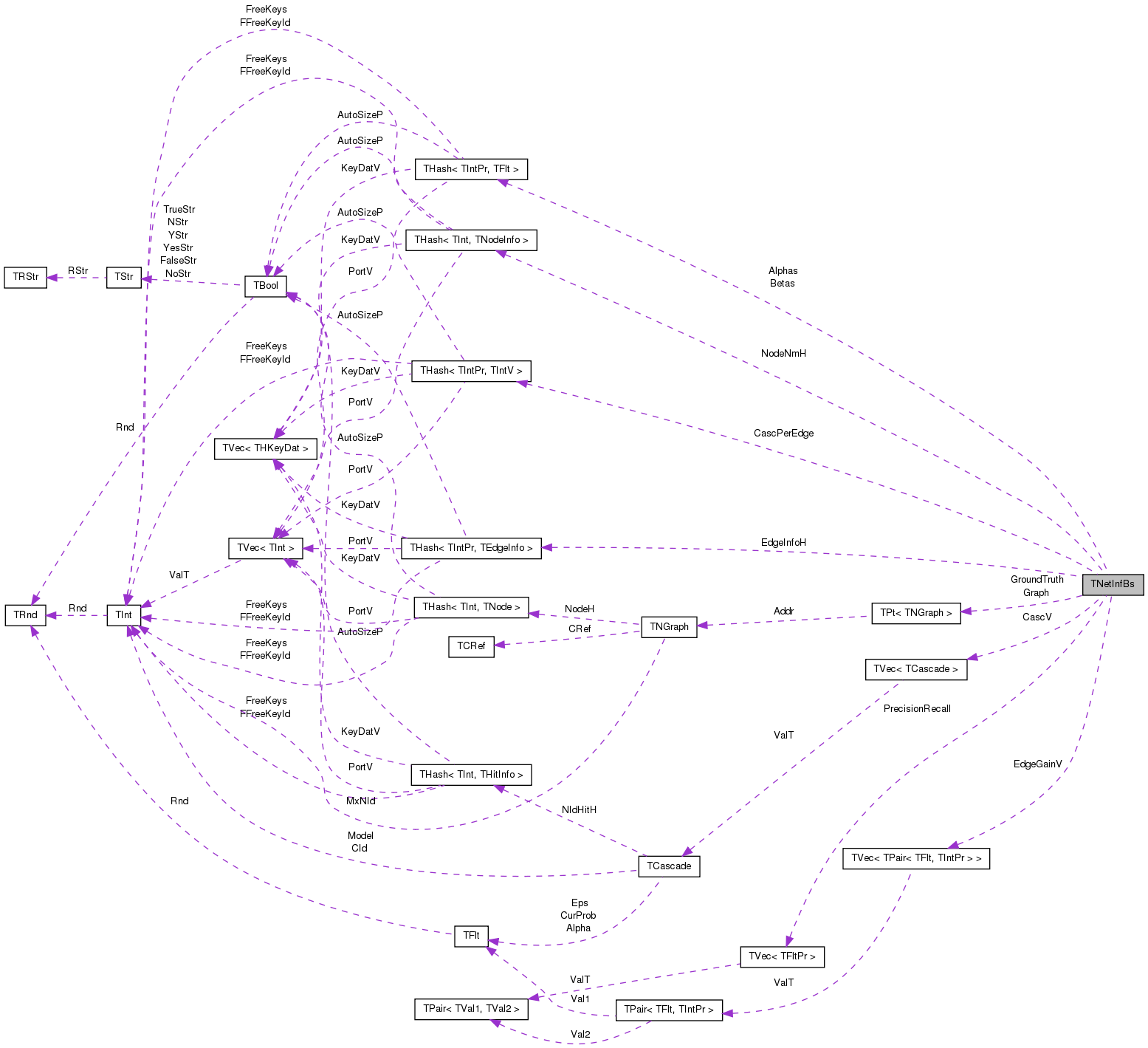
Public Member Functions | |
| TNetInfBs () | |
| TNetInfBs (bool bo, bool cgt) | |
| TNetInfBs (TSIn &SIn) | |
| void | Save (TSOut &SOut) const |
| void | LoadCascadesTxt (TSIn &SIn, const int &Model, const double &alpha) |
| void | LoadGroundTruthTxt (TSIn &SIn) |
| void | AddGroundTruth (PNGraph >) |
| void | AddCasc (const TStr &CascStr, const int &Model=0, const double &alpha=1.0) |
| void | AddCasc (const TCascade &Cascade) |
| void | GenCascade (TCascade &C, const int &TModel, const double &window, TIntPrIntH &EdgesUsed, const double &delta, const double &std_waiting_time=0, const double &std_beta=0) |
| TCascade & | GetCasc (int c) |
| int | GetCascs () |
| int | GetNodes () |
| void | AddNodeNm (const int &NId, const TNodeInfo &Info) |
| TStr | GetNodeNm (const int &NId) const |
| TNodeInfo | GetNodeInfo (const int &NId) const |
| bool | IsNodeNm (const int &NId) const |
| void | Init () |
| double | GetAllCascProb (const int &EdgeN1, const int &EdgeN2) |
| TIntPr | GetBestEdge (double &CurProb, double &LastGain, bool &msort, int &attempts) |
| double | GetBound (const TIntPr &Edge, double &CurProb) |
| void | GreedyOpt (const int &MxEdges) |
| void | SavePajek (const TStr &OutFNm) |
| void | SavePlaneTextNet (const TStr &OutFNm) |
| void | SaveEdgeInfo (const TStr &OutFNm) |
| void | SaveObjInfo (const TStr &OutFNm) |
| void | SaveGroundTruth (const TStr &OutFNm) |
| void | SaveCascades (const TStr &OutFNm) |
Public Attributes | |
| TVec< TCascade > | CascV |
| THash< TInt, TNodeInfo > | NodeNmH |
| THash< TIntPr, TEdgeInfo > | EdgeInfoH |
| TVec< TPair< TFlt, TIntPr > > | EdgeGainV |
| THash< TIntPr, TIntV > | CascPerEdge |
| PNGraph | Graph |
| PNGraph | GroundTruth |
| bool | BoundOn |
| bool | CompareGroundTruth |
| TFltPrV | PrecisionRecall |
| TIntPrFltH | Alphas |
| TIntPrFltH | Betas |
Definition at line 82 of file cascnetinf.h.
| TNetInfBs::TNetInfBs | ( | ) | [inline] |
Definition at line 97 of file cascnetinf.h.
References BoundOn, and CompareGroundTruth.
{ BoundOn = false; CompareGroundTruth=false; }
| TNetInfBs::TNetInfBs | ( | bool | bo, |
| bool | cgt | ||
| ) | [inline] |
Definition at line 98 of file cascnetinf.h.
References BoundOn, and CompareGroundTruth.
{ BoundOn=bo; CompareGroundTruth=cgt; }
| TNetInfBs::TNetInfBs | ( | TSIn & | SIn | ) | [inline] |
Definition at line 99 of file cascnetinf.h.
| void TNetInfBs::AddCasc | ( | const TStr & | CascStr, |
| const int & | Model = 0, |
||
| const double & | alpha = 1.0 |
||
| ) |
Definition at line 98 of file cascnetinf.cpp.
References TCascade::Add(), TVec< TVal >::Add(), CascV, GetNodeInfo(), TVec< TVal >::Len(), TCascade::Sort(), TStr::SplitOnAllCh(), and TNodeInfo::Vol.
Referenced by LoadCascadesTxt().
{
TStrV NIdV; CascStr.SplitOnAllCh(',', NIdV);
TCascade C(alpha, Model);
for (int i = 0; i < NIdV.Len(); i+=2) {
int NId;
double Tm;
NId = NIdV[i].GetInt();
Tm = NIdV[i+1].GetFlt();
GetNodeInfo(NId).Vol = GetNodeInfo(NId).Vol + 1;
C.Add(NId, Tm);
}
C.Sort();
CascV.Add(C);
}
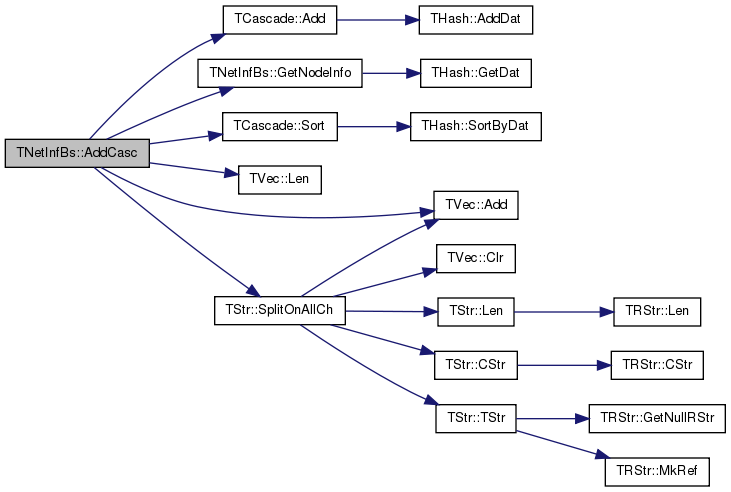

| void TNetInfBs::AddCasc | ( | const TCascade & | Cascade | ) | [inline] |
Definition at line 108 of file cascnetinf.h.
References TVec< TVal >::Add(), and CascV.

| void TNetInfBs::AddGroundTruth | ( | PNGraph & | gt | ) | [inline] |
| void TNetInfBs::AddNodeNm | ( | const int & | NId, |
| const TNodeInfo & | Info | ||
| ) | [inline] |
Definition at line 115 of file cascnetinf.h.
References THash< TKey, TDat, THashFunc >::AddDat(), and NodeNmH.
Referenced by LoadCascadesTxt().


| void TNetInfBs::GenCascade | ( | TCascade & | C, |
| const int & | TModel, | ||
| const double & | window, | ||
| TIntPrIntH & | EdgesUsed, | ||
| const double & | delta, | ||
| const double & | std_waiting_time = 0, |
||
| const double & | std_beta = 0 |
||
| ) |
Definition at line 113 of file cascnetinf.cpp.
References TCascade::Add(), THash< TKey, TDat, THashFunc >::AddDat(), Alphas, THash< TKey, TDat, THashFunc >::BegI(), Betas, TCascade::Clr(), THash< TKey, TDat, THashFunc >::Clr(), THash< TKey, TDat, THashFunc >::EndI(), THashKeyDatI< TKey, TDat >::GetDat(), THash< TKey, TDat, THashFunc >::GetDat(), TRnd::GetExpDev(), THashKeyDatI< TKey, TDat >::GetKey(), TFlt::GetMx(), TNGraph::GetNI(), TNGraph::GetNodes(), TNGraph::TNodeI::GetOutDeg(), TNGraph::TNodeI::GetOutNId(), TRnd::GetPowerDev(), TRnd::GetRayleigh(), TNGraph::GetRndNId(), GroundTruth, THash< TKey, TDat, THashFunc >::IsKey(), TCascade::Len(), TInt::Rnd, TFlt::Rnd, TCascade::Sort(), THash< TKey, TDat, THashFunc >::SortByDat(), and TInt::Val.
{
TIntFltH InfectedNIdH; TIntH InfectedBy;
double GlobalTime; int StartNId;
double alpha, beta;
if (GroundTruth->GetNodes() == 0)
return;
while (C.Len() < 2) {
C.Clr();
InfectedNIdH.Clr();
InfectedBy.Clr();
GlobalTime = 0;
StartNId = GroundTruth->GetRndNId();
InfectedNIdH.AddDat(StartNId) = GlobalTime;
while (true) {
// sort by time & get the oldest node that did not run infection
InfectedNIdH.SortByDat(true);
const int& NId = InfectedNIdH.BegI().GetKey();
GlobalTime = InfectedNIdH.BegI().GetDat();
// all the nodes has run infection
if (GlobalTime >= window)
break;
// add current oldest node to the network and set its time
C.Add(NId, GlobalTime);
// run infection from the current oldest node
const TNGraph::TNodeI NI = GroundTruth->GetNI(NId);
for (int e = 0; e < NI.GetOutDeg(); e++) {
const int DstNId = NI.GetOutNId(e);
beta = Betas.GetDat(TIntPr(NId, DstNId));
// flip biased coin (set by beta)
if (TInt::Rnd.GetUniDev() > beta+std_beta*TFlt::Rnd.GetNrmDev())
continue;
alpha = Alphas.GetDat(TIntPr(NId, DstNId));
// not infecting the parent
if (InfectedBy.IsKey(NId) && InfectedBy.GetDat(NId).Val == DstNId)
continue;
double sigmaT;
switch (TModel) {
case 0:
// exponential with alpha parameter
sigmaT = TInt::Rnd.GetExpDev(alpha);
break;
case 1:
// power-law with alpha parameter
sigmaT = TInt::Rnd.GetPowerDev(alpha);
while (sigmaT < delta) { sigmaT = TInt::Rnd.GetPowerDev(alpha); }
break;
case 2:
// rayleigh with alpha parameter
sigmaT = TInt::Rnd.GetRayleigh(1/sqrt(alpha));
break;
default:
sigmaT = 1;
break;
}
// avoid negative time diffs in case of noise
if (std_waiting_time > 0)
sigmaT = TFlt::GetMx(0.0, sigmaT + std_waiting_time*TFlt::Rnd.GetNrmDev());
double t1 = GlobalTime + sigmaT;
if (InfectedNIdH.IsKey(DstNId)) {
double t2 = InfectedNIdH.GetDat(DstNId);
if (t2 > t1 && t2 != window) {
InfectedNIdH.GetDat(DstNId) = t1;
InfectedBy.GetDat(DstNId) = NId;
}
} else {
InfectedNIdH.AddDat(DstNId) = t1;
InfectedBy.AddDat(DstNId) = NId;
}
}
// we cannot delete key (otherwise, we cannot sort), so we assign a big time (window cut-off)
InfectedNIdH.GetDat(NId) = window;
}
}
C.Sort();
for (TIntH::TIter EI = InfectedBy.BegI(); EI < InfectedBy.EndI(); EI++) {
TIntPr Edge(EI.GetDat().Val, EI.GetKey().Val);
if (!EdgesUsed.IsKey(Edge)) EdgesUsed.AddDat(Edge) = 0;
EdgesUsed.GetDat(Edge) += 1;
}
}
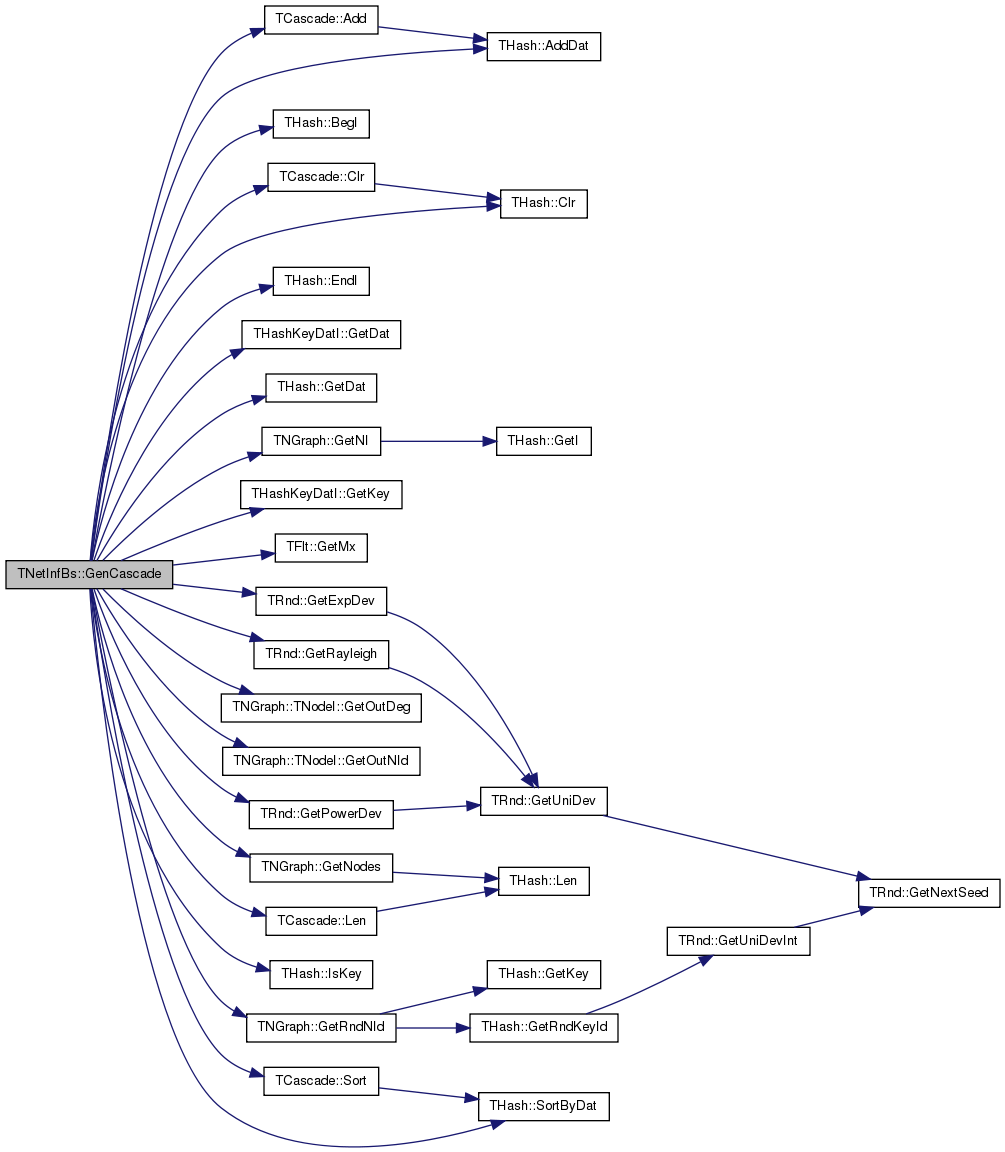
| double TNetInfBs::GetAllCascProb | ( | const int & | EdgeN1, |
| const int & | EdgeN2 | ||
| ) |
Definition at line 255 of file cascnetinf.cpp.
References CascPerEdge, CascV, THash< TKey, TDat, THashFunc >::GetDat(), and TVec< TVal >::Len().
Referenced by GetBestEdge(), GetBound(), and GreedyOpt().
{
double P = 0.0;
if (EdgeN1==-1 && EdgeN2==-1) {
for (int c = 0; c < CascV.Len(); c++) {
P += CascV[c].UpdateProb(EdgeN1, EdgeN2, false); } // initial log-likelihood
return P;
}
TIntV &CascsEdge = CascPerEdge.GetDat(TIntPr(EdgeN1, EdgeN2)); // only check cascades that contain the edge
for (int c = 0; c < CascsEdge.Len(); c++) {
P += (CascV[CascsEdge[c]].UpdateProb(EdgeN1, EdgeN2, false) - CascV[CascsEdge[c]].CurProb); } // marginal gain
return P;
}


| TIntPr TNetInfBs::GetBestEdge | ( | double & | CurProb, |
| double & | LastGain, | ||
| bool & | msort, | ||
| int & | attempts | ||
| ) |
Definition at line 271 of file cascnetinf.cpp.
References TVec< TVal >::Add(), TVec< TVal >::Del(), EdgeGainV, GetAllCascProb(), TNGraph::GetEdges(), Graph, TNGraph::IsEdge(), TVec< TVal >::Len(), TMath::Mn(), TFlt::Mn, TVec< TVal >::Sort(), TPair< TVal1, TVal2 >::Val1, and TPair< TVal1, TVal2 >::Val2.
Referenced by GreedyOpt().
{
TIntPr BestE;
TVec<TInt> KeysV;
TVec<TPair<TFlt, TIntPr> > EdgeGainCopyToSortV;
TIntV EdgeZero;
double BestGain = TFlt::Mn;
int BestGainIndex = -1;
if (msort) {
for (int i=0; i<TMath::Mn(attempts-1, EdgeGainV.Len()); i++)
EdgeGainCopyToSortV.Add(EdgeGainV[i]);
// printf("Sorting sublist of size %d of marginal gains!\n", EdgeGainCopyToSortV.Len());
// sort this list
EdgeGainCopyToSortV.Sort(false);
// printf("Sublist sorted!\n");
// clever way of resorting without need to copy (google interview question! :-))
for (int i=0, ii=0, j=0; ii < EdgeGainCopyToSortV.Len(); j++) {
if ( (i+EdgeGainCopyToSortV.Len() < EdgeGainV.Len()) && (EdgeGainCopyToSortV[ii].Val1 < EdgeGainV[i+EdgeGainCopyToSortV.Len()].Val1) ) {
EdgeGainV[j] = EdgeGainV[i+EdgeGainCopyToSortV.Len()];
i++;
} else {
EdgeGainV[j] = EdgeGainCopyToSortV[ii];
ii++;
}
}
}
attempts = 0;
for (int e = 0; e < EdgeGainV.Len(); e++) {
const TIntPr& Edge = EdgeGainV[e].Val2;
if (Graph->IsEdge(Edge.Val1, Edge.Val2)) { continue; } // if edge was already included in the graph
const double EProb = GetAllCascProb(Edge.Val1, Edge.Val2);
EdgeGainV[e].Val1 = EProb; // update marginal gain
if (BestGain < EProb) {
BestGain = EProb;
BestGainIndex = e;
BestE = Edge;
}
// if we only update one weight, we don't need to sort the list
attempts++;
// keep track of zero edges after sorting once the full list
if (!Graph->IsEdge(Edge.Val1, Edge.Val2) && Graph->GetEdges() > 1) {
if (EProb == 0)
EdgeZero.Add(e);
}
// lazy evaluation
if (e+1 == EdgeGainV.Len() || BestGain >= EdgeGainV[e+1].Val1) {
CurProb += BestGain;
if (BestGain == 0)
return TIntPr(-1, -1);
EdgeGainV.Del(BestGainIndex);
// we know the edges in 0 will be in sorted order, so we start from the biggest
for (int i=EdgeZero.Len()-1; i>=0; i--) {
if (EdgeZero[i] > BestGainIndex)
EdgeGainV.Del(EdgeZero[i]-1);
else
EdgeGainV.Del(EdgeZero[i]);
}
if (EdgeZero.Len() > 2) { attempts -= (EdgeZero.Len()-1); }
msort = (attempts > 1);
LastGain = BestGain;
return BestE;
}
}
printf("Edges exhausted!\n");
return TIntPr(-1, -1);
}
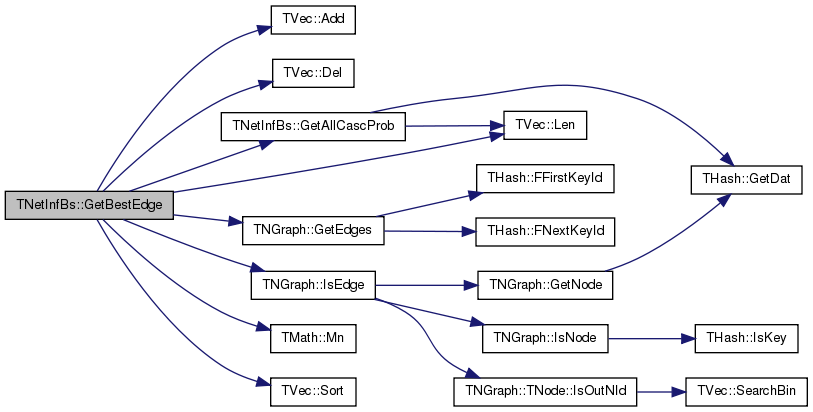

| double TNetInfBs::GetBound | ( | const TIntPr & | Edge, |
| double & | CurProb | ||
| ) |
Definition at line 356 of file cascnetinf.cpp.
References TVec< TVal >::Add(), EdgeGainV, GetAllCascProb(), TNGraph::GetEdges(), Graph, TNGraph::IsEdge(), TVec< TVal >::Len(), TVec< TVal >::Sort(), TPair< TVal1, TVal2 >::Val1, and TPair< TVal1, TVal2 >::Val2.
{
double Bound = 0;
TFltV Bounds;
// bound could be computed faster (using lazy evaluation, as in the optimization procedure)
for (int e=0; e < EdgeGainV.Len(); e++) {
const TIntPr& EE = EdgeGainV[e].Val2;
if (EE != Edge && !Graph->IsEdge(EE.Val1, EE.Val2)) {
const double EProb = GetAllCascProb(EE.Val1, EE.Val2);
if (EProb > CurProb) Bounds.Add(EProb - CurProb); }
}
Bounds.Sort(false);
for (int i=0; i<Graph->GetEdges() && i<Bounds.Len(); i++) Bound += Bounds[i];
return Bound;
}
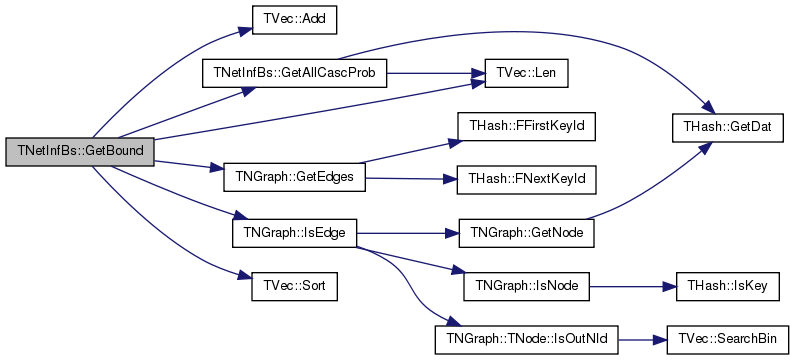
| TCascade& TNetInfBs::GetCasc | ( | int | c | ) | [inline] |
| int TNetInfBs::GetCascs | ( | ) | [inline] |
Definition at line 112 of file cascnetinf.h.
References CascV, and TVec< TVal >::Len().

| TNodeInfo TNetInfBs::GetNodeInfo | ( | const int & | NId | ) | const [inline] |
Definition at line 117 of file cascnetinf.h.
References THash< TKey, TDat, THashFunc >::GetDat(), and NodeNmH.
Referenced by AddCasc().


| TStr TNetInfBs::GetNodeNm | ( | const int & | NId | ) | const [inline] |
Definition at line 116 of file cascnetinf.h.
References THash< TKey, TDat, THashFunc >::GetDat(), TNodeInfo::Name, and NodeNmH.

| int TNetInfBs::GetNodes | ( | ) | [inline] |
Definition at line 114 of file cascnetinf.h.
References TNGraph::GetNodes(), and Graph.

| void TNetInfBs::GreedyOpt | ( | const int & | MxEdges | ) |
Definition at line 374 of file cascnetinf.cpp.
References TVec< TVal >::Add(), THash< TKey, TDat, THashFunc >::AddDat(), TNGraph::AddEdge(), CascPerEdge, CascV, CompareGroundTruth, EdgeGainV, EdgeInfoH, GetAllCascProb(), GetBestEdge(), THash< TKey, TDat, THashFunc >::GetDat(), TNGraph::GetEdges(), Graph, GroundTruth, TNGraph::IsEdge(), TVec< TVal >::Len(), TFlt::Mx, PrecisionRecall, TVec< TVal >::Sort(), TPair< TVal1, TVal2 >::Val1, and TPair< TVal1, TVal2 >::Val2.
{
double CurProb = GetAllCascProb(-1, -1);
double LastGain = TFlt::Mx;
int attempts = 0;
bool msort = false;
for (int k = 0; k < MxEdges && EdgeGainV.Len() > 0; k++) {
const TIntPr BestE = GetBestEdge(CurProb, LastGain, msort, attempts);
if (BestE == TIntPr(-1, -1)) // if we cannot add more edges, we stop
break;
if (CompareGroundTruth) {
double precision = 0, recall = 0;
if (PrecisionRecall.Len() > 1) {
precision = PrecisionRecall[PrecisionRecall.Len()-1].Val2.Val;
recall = PrecisionRecall[PrecisionRecall.Len()-1].Val1.Val;
}
if (GroundTruth->IsEdge(BestE.Val1, BestE.Val2)) {
recall++;
} else {
precision++;
}
PrecisionRecall.Add(TPair<TFlt, TFlt>(recall, precision));
}
Graph->AddEdge(BestE.Val1, BestE.Val2); // add edge to network
// localized update!
TIntV &CascsEdge = CascPerEdge.GetDat(BestE); // only check cascades that contain the edge
for (int c = 0; c < CascsEdge.Len(); c++) {
CascV[CascsEdge[c]].UpdateProb(BestE.Val1, BestE.Val2, true); // update probabilities
}
// some extra info for the added edge
TInt Vol; TFlt AverageTimeDiff; TFltV TimeDiffs;
Vol = 0; AverageTimeDiff = 0;
for (int i=0; i< CascV.Len(); i++) {
if (CascV[i].IsNode(BestE.Val2) && CascV[i].GetParent(BestE.Val2) == BestE.Val1) {
Vol += 1; TimeDiffs.Add(CascV[i].GetTm(BestE.Val2)-CascV[i].GetTm(BestE.Val1));
AverageTimeDiff += TimeDiffs[TimeDiffs.Len()-1]; }
}
AverageTimeDiff /= Vol;
if (TimeDiffs.Len() > 0)
TimeDiffs.Sort();
else
TimeDiffs.Add(0);
// compute bound only if explicitly required
EdgeInfoH.AddDat(BestE) = TEdgeInfo(Vol,
LastGain,
0.0,
TimeDiffs[(int)(TimeDiffs.Len()/2)],
AverageTimeDiff);
}
if (CompareGroundTruth) {
for (int i=0; i<PrecisionRecall.Len(); i++) {
PrecisionRecall[i].Val2 = 1.0 - PrecisionRecall[i].Val2/(PrecisionRecall[i].Val2+PrecisionRecall[i].Val1);
PrecisionRecall[i].Val1 /= (double)GroundTruth->GetEdges();
}
}
}
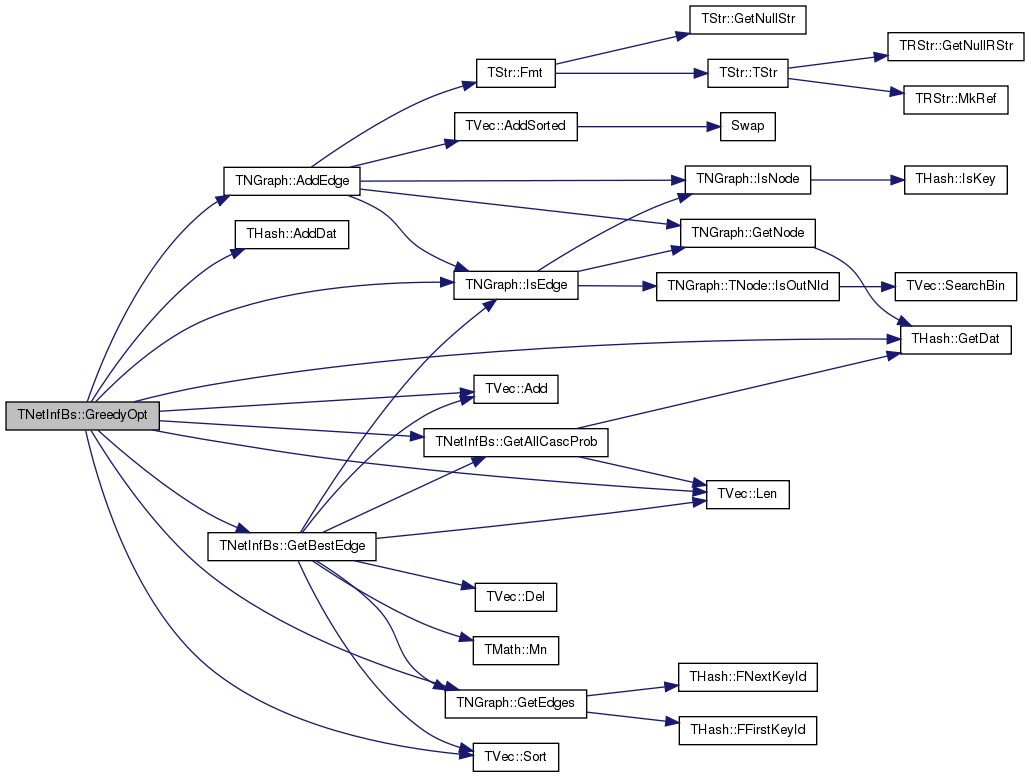
| void TNetInfBs::Init | ( | ) |
Definition at line 216 of file cascnetinf.cpp.
References TVec< TVal >::Add(), THash< TKey, TDat, THashFunc >::AddDat(), TNGraph::AddNode(), TNGraph::BegNI(), CascPerEdge, CascV, THash< TKey, TDat, THashFunc >::Clr(), TVec< TVal >::Clr(), EdgeGainV, TNGraph::EndNI(), THash< TKey, TDat, THashFunc >::GetDat(), Graph, THash< TKey, TDat, THashFunc >::IsKey(), TNGraph::IsNode(), TVec< TVal >::Len(), TFlt::Mx, TNGraph::New(), and PrecisionRecall.
{
THash<TInt, TIntV> CascPN;
Graph = TNGraph::New();
// reset vectors
EdgeGainV.Clr();
CascPerEdge.Clr();
PrecisionRecall.Clr();
for (int c = 0; c < CascV.Len(); c++) {
for (int i = 0; i < CascV[c].Len(); i++) {
if (!Graph->IsNode(CascV[c].GetNode(i))) Graph->AddNode(CascV[c].GetNode(i));
if (!CascPN.IsKey(CascV[c].GetNode(i))) CascPN.AddDat(CascV[c].GetNode(i)) = TIntV();
CascPN.GetDat(CascV[c].GetNode(i)).Add(c);
}
CascV[c].InitProb();
}
// only add edges that make sense (i.e., at least once coherent in time)
for (TNGraph::TNodeI NI = Graph->BegNI(); NI < Graph->EndNI(); NI++) {
TIntV &Cascs = CascPN.GetDat(NI.GetId());
for (int c = 0; c < Cascs.Len(); c++) {
for (int i=0; i < CascV[Cascs[c]].Len(); i++) {
if (CascV[Cascs[c]].GetNode(i)==NI.GetId())
continue;
if (CascV[Cascs[c]].GetTm(CascV[Cascs[c]].GetNode(i)) < CascV[Cascs[c]].GetTm(NI.GetId()) ) {
if (!CascPerEdge.IsKey(TIntPr(CascV[Cascs[c]].GetNode(i), NI.GetId()))) {
EdgeGainV.Add(TPair<TFlt, TIntPr>(TFlt::Mx, TIntPr(CascV[Cascs[c]].GetNode(i), NI.GetId())));
CascPerEdge.AddDat(TIntPr(CascV[Cascs[c]].GetNode(i), NI.GetId())) = TIntV();
}
// Add cascade to hash of cascades per edge (to implement localized update)
CascPerEdge.GetDat(TIntPr(CascV[Cascs[c]].GetNode(i), NI.GetId())).Add(Cascs[c]);
}
}
}
}
}
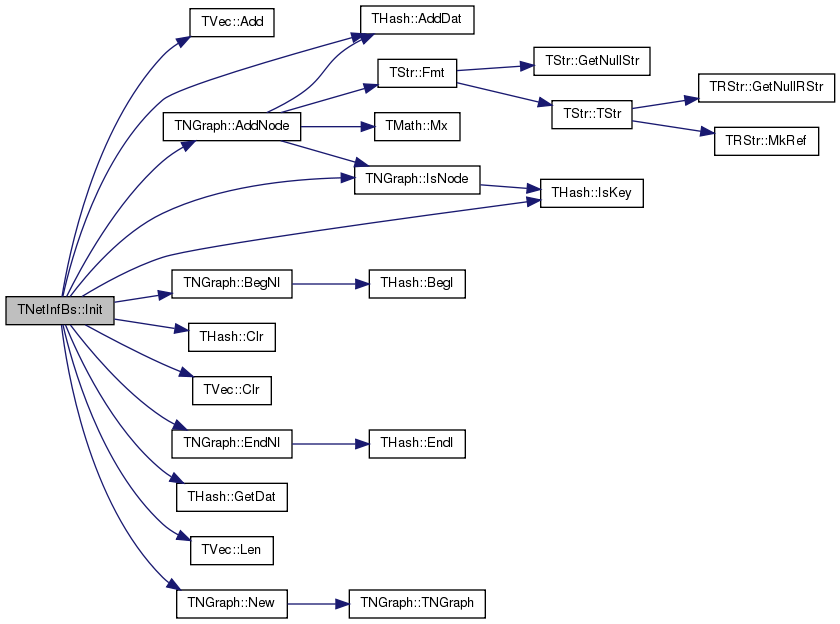
| bool TNetInfBs::IsNodeNm | ( | const int & | NId | ) | const [inline] |
Definition at line 118 of file cascnetinf.h.
References THash< TKey, TDat, THashFunc >::IsKey(), and NodeNmH.

| void TNetInfBs::LoadCascadesTxt | ( | TSIn & | SIn, |
| const int & | Model, | ||
| const double & | alpha | ||
| ) |
Definition at line 62 of file cascnetinf.cpp.
References AddCasc(), AddNodeNm(), TSIn::Eof(), TSIn::GetNextLn(), and TStr::SplitOnAllCh().
{
TStr Line;
while (!SIn.Eof()) {
SIn.GetNextLn(Line);
if (Line=="") { break; }
TStrV NIdV; Line.SplitOnAllCh(',', NIdV);
AddNodeNm(NIdV[0].GetInt(), TNodeInfo(NIdV[1], 0));
}
printf("All nodes read!\n");
while (!SIn.Eof()) { SIn.GetNextLn(Line); AddCasc(Line, Model, alpha); }
printf("All cascades read!\n");
}
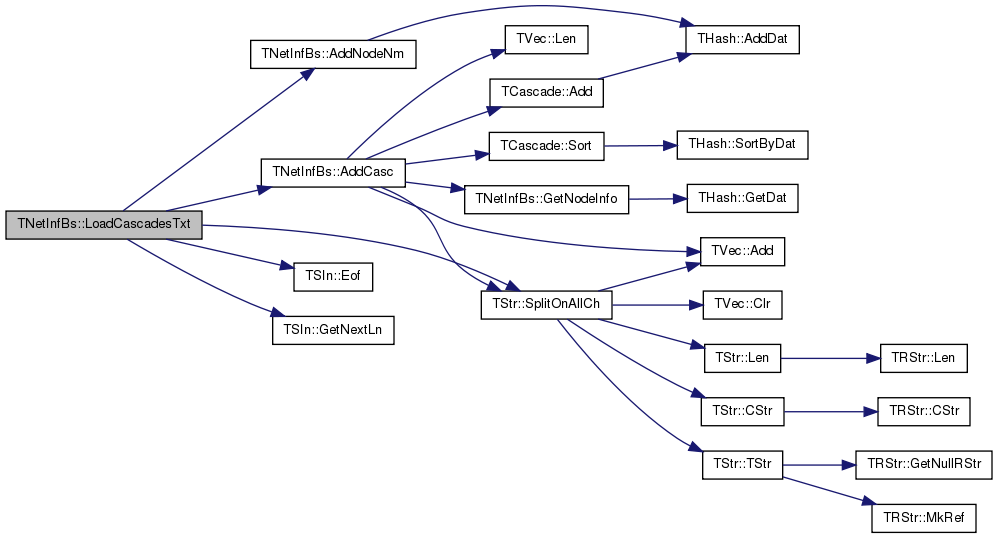
| void TNetInfBs::LoadGroundTruthTxt | ( | TSIn & | SIn | ) |
Definition at line 75 of file cascnetinf.cpp.
References THash< TKey, TDat, THashFunc >::AddDat(), TNGraph::AddEdge(), TNGraph::AddNode(), Alphas, TSIn::Eof(), TNGraph::GetEdges(), TSIn::GetNextLn(), TNGraph::GetNodes(), GroundTruth, TVec< TVal >::Len(), TNGraph::New(), and TStr::SplitOnAllCh().
{
GroundTruth = TNGraph::New(); TStr Line;
// add nodes
while (!SIn.Eof()) {
SIn.GetNextLn(Line);
if (Line=="") { break; }
TStrV NIdV; Line.SplitOnAllCh(',', NIdV);
GroundTruth->AddNode(NIdV[0].GetInt());
}
// add edges
while (!SIn.Eof()) {
SIn.GetNextLn(Line);
TStrV NIdV; Line.SplitOnAllCh(',', NIdV);
GroundTruth->AddEdge(NIdV[0].GetInt(), NIdV[1].GetInt());
if (NIdV.Len()>2) { Alphas.AddDat(TIntPr(NIdV[0].GetInt(), NIdV[1].GetInt())) = NIdV[2].GetFlt(); }
else { Alphas.AddDat(TIntPr(NIdV[0].GetInt(), NIdV[1].GetInt())) = 1.0; }
}
printf("groundtruth nodes:%d edges:%d\n", GroundTruth->GetNodes(), GroundTruth->GetEdges());
}
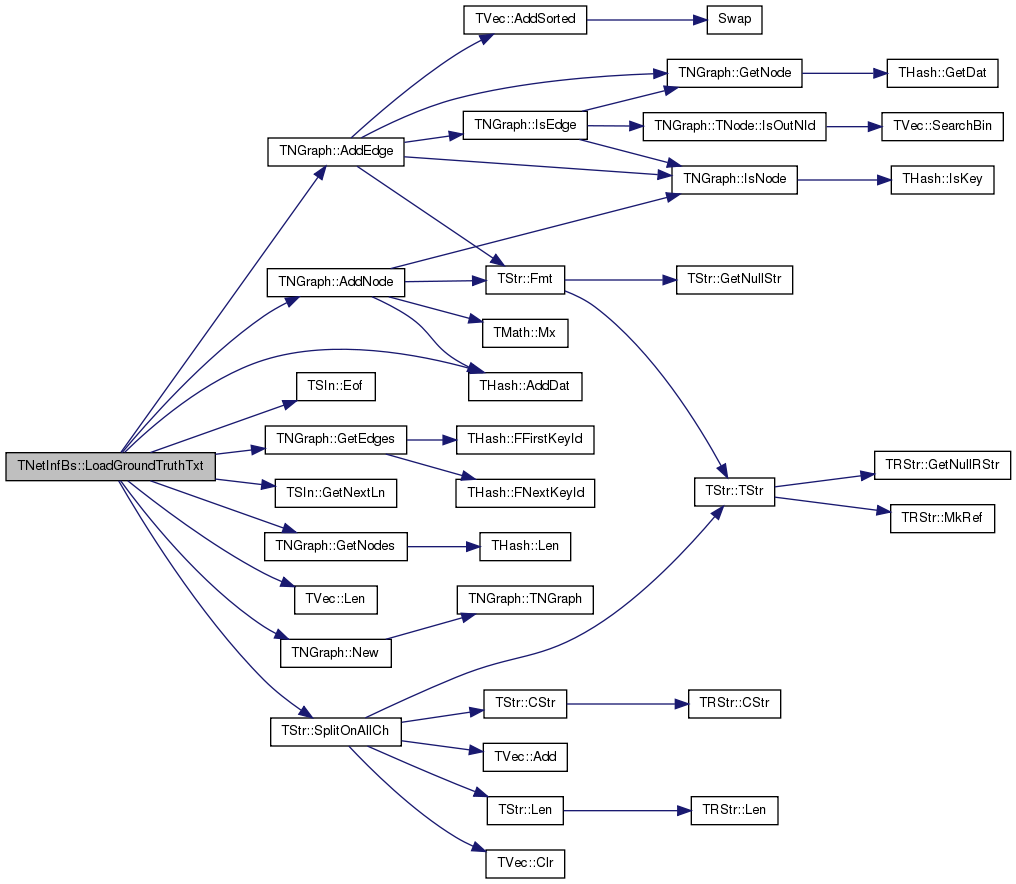
| void TNetInfBs::Save | ( | TSOut & | SOut | ) | const [inline] |
Definition at line 100 of file cascnetinf.h.
References CascV, NodeNmH, THash< TKey, TDat, THashFunc >::Save(), and TVec< TVal >::Save().

| void TNetInfBs::SaveCascades | ( | const TStr & | OutFNm | ) |
Definition at line 524 of file cascnetinf.cpp.
References THash< TKey, TDat, THashFunc >::BegI(), TNGraph::BegNI(), CascV, THash< TKey, TDat, THashFunc >::EndI(), TNGraph::EndNI(), TStr::Fmt(), GroundTruth, TCascade::Len(), TVec< TVal >::Len(), TCascade::NIdHitH, and TSOut::PutStr().
{
TFOut FOut(OutFNm);
// write nodes to file
for (TNGraph::TNodeI NI = GroundTruth->BegNI(); NI < GroundTruth->EndNI(); NI++) {
FOut.PutStr(TStr::Fmt("%d,%d\r\n", NI.GetId(), NI.GetId())); // nodes
}
FOut.PutStr("\r\n");
// write cascades to file
for (int i=0; i<CascV.Len(); i++) {
TCascade &C = CascV[i];
int j = 0;
for (THash<TInt, THitInfo>::TIter NI = C.NIdHitH.BegI(); NI < C.NIdHitH.EndI(); NI++, j++) {
if (j > 0)
FOut.PutStr(TStr::Fmt(",%d,%f", NI.GetDat().NId.Val, NI.GetDat().Tm.Val));
else
FOut.PutStr(TStr::Fmt("%d,%f", NI.GetDat().NId.Val, NI.GetDat().Tm.Val));
}
if (C.Len() >= 1)
FOut.PutStr(TStr::Fmt("\r\n"));
}
}
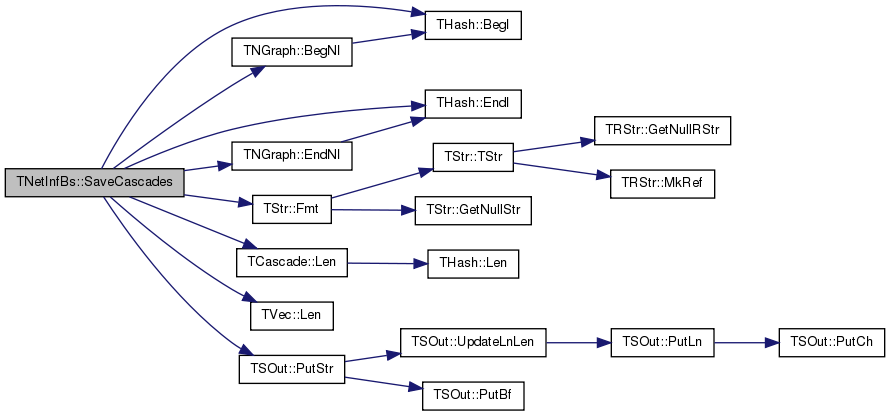
| void TNetInfBs::SaveEdgeInfo | ( | const TStr & | OutFNm | ) |
Definition at line 470 of file cascnetinf.cpp.
References TEdgeInfo::AverageTimeDiff, THash< TKey, TDat, THashFunc >::BegI(), TStr::CStr(), EdgeInfoH, THash< TKey, TDat, THashFunc >::EndI(), THash< TKey, TDat, THashFunc >::GetDat(), TEdgeInfo::MarginalGain, TEdgeInfo::MedianTimeDiff, NodeNmH, TInt::Val, TFlt::Val, and TEdgeInfo::Vol.
{
FILE *F = fopen(OutFNm.CStr(), "wt");
fprintf(F, "src dst vol marginal_gain median_timediff average_timediff\n");
for (THash<TIntPr, TEdgeInfo>::TIter EI = EdgeInfoH.BegI(); EI < EdgeInfoH.EndI(); EI++) {
TEdgeInfo &EdgeInfo = EI.GetDat();
fprintf(F, "%s/%s/%d/%f/%f/%f\n",
NodeNmH.GetDat(EI.GetKey().Val1.Val).Name.CStr(), NodeNmH.GetDat(EI.GetKey().Val2.Val).Name.CStr(),
EdgeInfo.Vol.Val, EdgeInfo.MarginalGain.Val,
EdgeInfo.MedianTimeDiff.Val,
EdgeInfo.AverageTimeDiff.Val);
}
fclose(F);
}
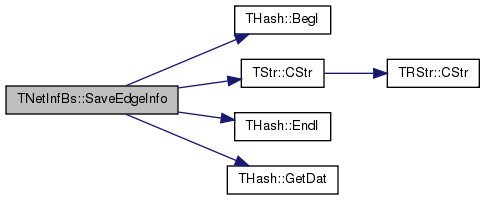
| void TNetInfBs::SaveGroundTruth | ( | const TStr & | OutFNm | ) |
Definition at line 502 of file cascnetinf.cpp.
References Alphas, TNGraph::BegEI(), TNGraph::BegNI(), TNGraph::EndEI(), TNGraph::EndNI(), TStr::Fmt(), THash< TKey, TDat, THashFunc >::GetDat(), GroundTruth, THash< TKey, TDat, THashFunc >::IsKey(), TSOut::PutStr(), and TFlt::Val.
{
TFOut FOut(OutFNm);
// write nodes to file
for (TNGraph::TNodeI NI = GroundTruth->BegNI(); NI < GroundTruth->EndNI(); NI++) {
FOut.PutStr(TStr::Fmt("%d,%d\r\n", NI.GetId(), NI.GetId())); // nodes
}
FOut.PutStr("\r\n");
// write edges to file (not allowing self loops in the network)
for (TNGraph::TEdgeI EI = GroundTruth->BegEI(); EI < GroundTruth->EndEI(); EI++) {
// not allowing self loops in the Kronecker network
if (EI.GetSrcNId() != EI.GetDstNId()) {
if (Alphas.IsKey(TIntPr(EI.GetSrcNId(), EI.GetDstNId())))
FOut.PutStr(TStr::Fmt("%d,%d,%f\r\n", EI.GetSrcNId(), EI.GetDstNId(), Alphas.GetDat(TIntPr(EI.GetSrcNId(), EI.GetDstNId())).Val));
else
FOut.PutStr(TStr::Fmt("%d,%d,1\r\n", EI.GetSrcNId(), EI.GetDstNId()));
}
}
}
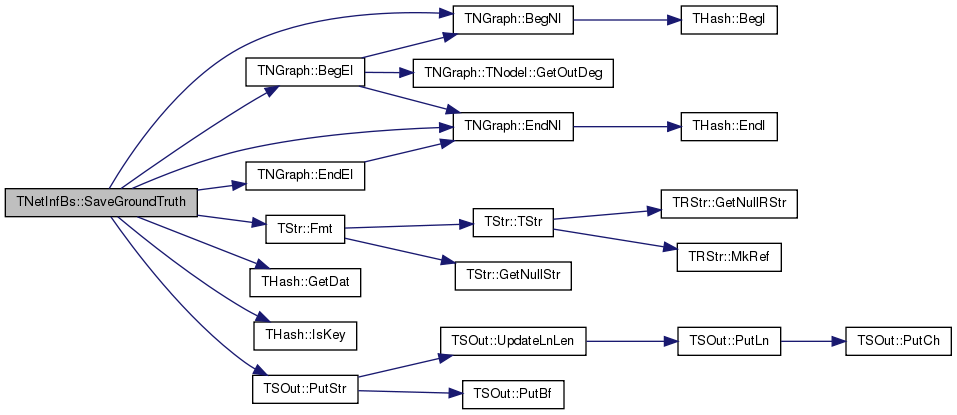
| void TNetInfBs::SaveObjInfo | ( | const TStr & | OutFNm | ) |
Definition at line 485 of file cascnetinf.cpp.
References TVec< TVal >::Add(), TGnuPlot::AddPlot(), THash< TKey, TDat, THashFunc >::BegI(), EdgeInfoH, THash< TKey, TDat, THashFunc >::EndI(), TVec< TVal >::GetDat(), gpwLinesPoints, TVec< TVal >::Len(), and TGnuPlot::SavePng().
{
TGnuPlot GnuPlot(OutFNm);
TFltV Objective;
for (THash<TIntPr, TEdgeInfo>::TIter EI = EdgeInfoH.BegI(); EI < EdgeInfoH.EndI(); EI++) {
if (Objective.Len()==0) { Objective.Add(EI.GetDat().MarginalGain);
} else {
Objective.Add(Objective[Objective.Len()-1]+EI.GetDat().MarginalGain);
}
}
GnuPlot.AddPlot(Objective, gpwLinesPoints);
GnuPlot.SavePng();
}
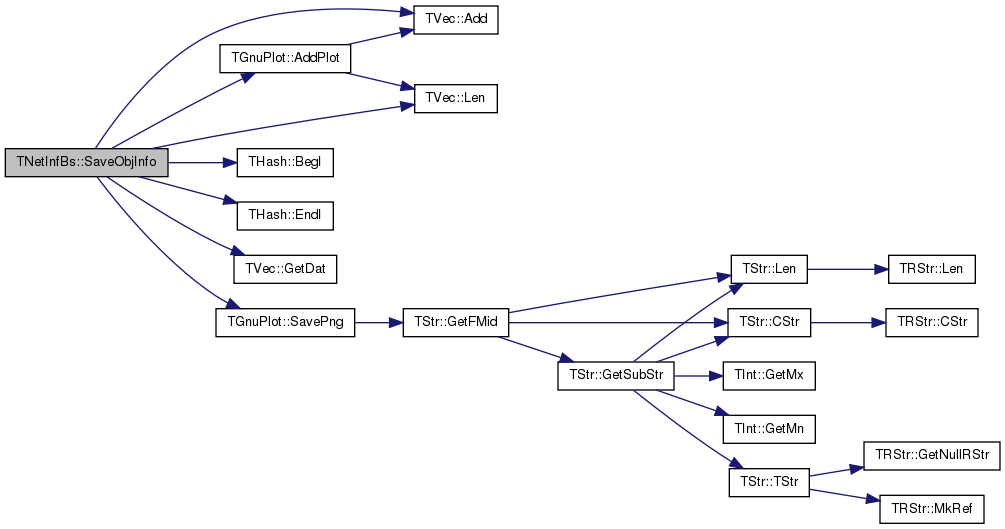
| void TNetInfBs::SavePajek | ( | const TStr & | OutFNm | ) |
Definition at line 439 of file cascnetinf.cpp.
References TNGraph::BegEI(), THash< TKey, TDat, THashFunc >::BegI(), TStr::CStr(), TNGraph::EndEI(), THash< TKey, TDat, THashFunc >::EndI(), Graph, THashSet< TKey, THashFunc >::Len(), TNodeInfo::Name, NodeNmH, and TNodeInfo::Vol.
{
TIntSet NIdSet;
FILE *F = fopen(OutFNm.CStr(), "wt");
fprintf(F, "*Vertices %d\r\n", NIdSet.Len());
for (THash<TInt, TNodeInfo>::TIter NI = NodeNmH.BegI(); NI < NodeNmH.EndI(); NI++) {
const TNodeInfo& I = NI.GetDat();
fprintf(F, "%d \"%s\" ic Blue x_fact %f y_fact %f\r\n", NI.GetKey().Val,
I.Name.CStr(), TMath::Mx<double>(log((double)I.Vol)-5,1), TMath::Mx<double>(log((double)I.Vol)-5,1));
}
fprintf(F, "*Arcs\r\n");
for (TNGraph::TEdgeI EI = Graph->BegEI(); EI < Graph->EndEI(); EI++) {
fprintf(F, "%d %d 1\r\n", EI.GetSrcNId(), EI.GetDstNId());
}
fclose(F);
}
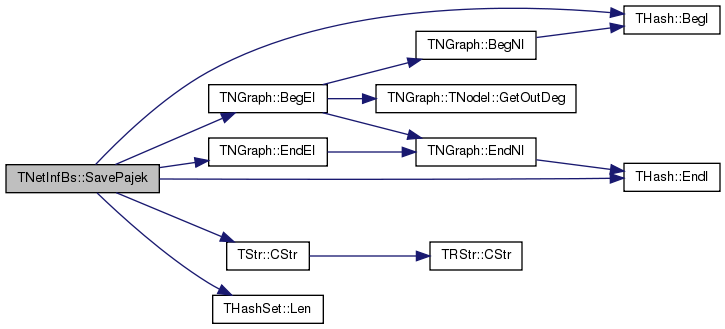
| void TNetInfBs::SavePlaneTextNet | ( | const TStr & | OutFNm | ) |
Definition at line 455 of file cascnetinf.cpp.
References TNGraph::BegEI(), THash< TKey, TDat, THashFunc >::BegI(), TStr::CStr(), TNGraph::EndEI(), THash< TKey, TDat, THashFunc >::EndI(), Graph, and NodeNmH.
{
TIntSet NIdSet;
FILE *F = fopen(OutFNm.CStr(), "wt");
for (THash<TInt, TNodeInfo>::TIter NI = NodeNmH.BegI(); NI < NodeNmH.EndI(); NI++) {
fprintf(F, "%d,%d\r\n", NI.GetKey().Val, NI.GetKey().Val);
}
fprintf(F, "\r\n");
for (TNGraph::TEdgeI EI = Graph->BegEI(); EI < Graph->EndEI(); EI++) {
fprintf(F, "%d,%d\r\n", EI.GetSrcNId(), EI.GetDstNId());
}
fclose(F);
}
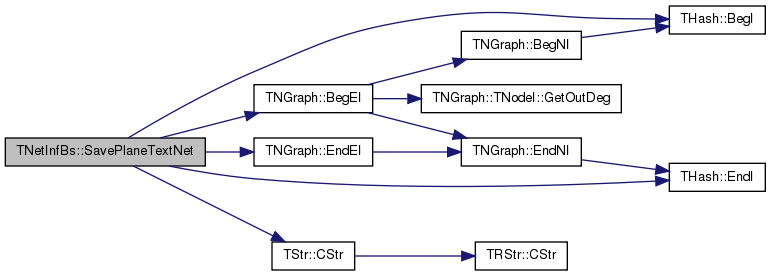
Definition at line 94 of file cascnetinf.h.
Referenced by GenCascade(), LoadGroundTruthTxt(), and SaveGroundTruth().
Definition at line 94 of file cascnetinf.h.
Referenced by GenCascade().
| bool TNetInfBs::BoundOn |
Definition at line 91 of file cascnetinf.h.
Referenced by TNetInfBs().
Definition at line 89 of file cascnetinf.h.
Referenced by GetAllCascProb(), GreedyOpt(), and Init().
Definition at line 84 of file cascnetinf.h.
Referenced by AddCasc(), GetAllCascProb(), GetCasc(), GetCascs(), GreedyOpt(), Init(), Save(), and SaveCascades().
Definition at line 91 of file cascnetinf.h.
Referenced by GreedyOpt(), and TNetInfBs().
Definition at line 87 of file cascnetinf.h.
Referenced by GetBestEdge(), GetBound(), GreedyOpt(), and Init().
Definition at line 86 of file cascnetinf.h.
Referenced by GreedyOpt(), SaveEdgeInfo(), and SaveObjInfo().
Definition at line 90 of file cascnetinf.h.
Referenced by GetBestEdge(), GetBound(), GetNodes(), GreedyOpt(), Init(), SavePajek(), and SavePlaneTextNet().
Definition at line 90 of file cascnetinf.h.
Referenced by AddGroundTruth(), GenCascade(), GreedyOpt(), LoadGroundTruthTxt(), SaveCascades(), and SaveGroundTruth().
Definition at line 85 of file cascnetinf.h.
Referenced by AddNodeNm(), GetNodeInfo(), GetNodeNm(), IsNodeNm(), Save(), SaveEdgeInfo(), SavePajek(), and SavePlaneTextNet().
Definition at line 92 of file cascnetinf.h.
Referenced by GreedyOpt(), and Init().